Traditional instruments in the Ethnographic Museum of Istria - from the Museum's foundation until today
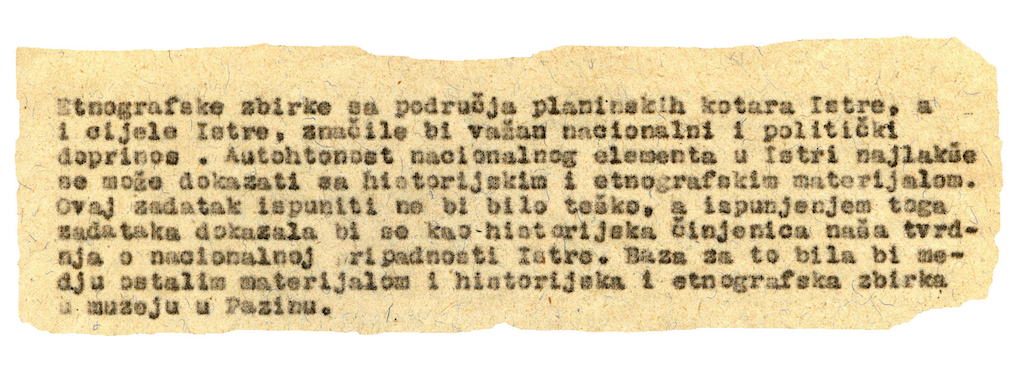 Excerpt from the "Proposal for the organization of the National Museum in Pazin", 18. 5. 1955, Antun Bauer and Ante Čıtlak. From the archives of MGP.
Excerpt from the "Proposal for the organization of the National Museum in Pazin", 18. 5. 1955, Antun Bauer and Ante Čıtlak. From the archives of MGP.
The beginninings
The process of collecting items that will later become part of the holdings of the Ethnographic Museum of Istria begins during the 50s in the 20th century. At that time the restoration of the medieval castle in Pazin has been initiated and in 1955 the National Museum of Pazin (1) starts with its activities there. The importance of establishing a central museum for the cultural and historical development of Istria was stressed in the Proposal for the organization of the National Museum in Pazin by the eminent Croatian museologist Dr. Antun Bauer and the first director of the National Museum in Pazin, Dr. Ante Čıtlak. They observed that changes that occur in the "economic and social structure" condition the transformation of culture and, as they say, the disappearance of its traditional forms. It’s clear from the aforementioned text that the ethnographic collection, as a material witness of traditional culture in Istria, is not only aimed at preserving the particularities of the local culture in the “musealized” form of those times. An equally important goal of establishing an ethnographic collection in the new museum was of a political nature. In the political and social context of Istria after World War II, in addition to what was mentioned before, the ethnographic collection had the function to additionally evidence and argument "the autochthonous Croatian element in Istria on its entire territory."
The first exhibition of items from the ethnographic collection was opened in the Kaštel marking the celebration of the former Republic Day on November 29, 1957. The thematic review of traditional food preparation in the kitchen areas of the Kaštel opened the way for the establishment of the Ethnographic Museum of Istria. In the next period the tours of Istrian villages to collect museum material continued. Exactly four years after the first exhibition, the second part of the permanent exhibition opens with the exhibits of traditional clothing and traditional musical instruments from different parts of Istria. Responsible for collecting objects, design ideas and the realization of the exhibition were former museum employees Ljubomir Petrović and Marija Križmanić. Shortly afterwards, in May 1962, the National Museum of Pazin was officially renamed the Ethnographic Museum of Istria. From then until the present day, the permanent collection of the Museum has on several occasions, to a greater or lesser extent, been subject to amendments (1968, 1973, 1976 and 1986), and traditional instruments always found their place in it.
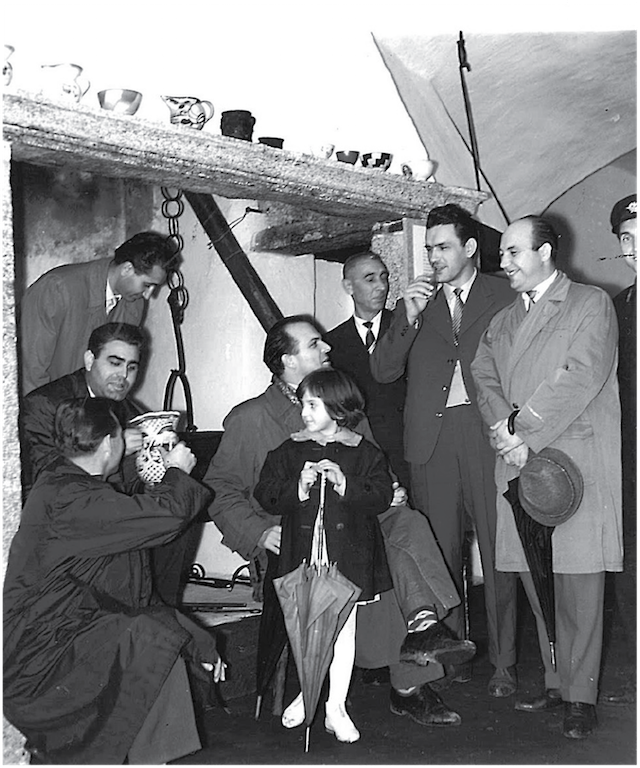 The opening of the permanent exhibition 29th November 1961, MGP Archive.
The opening of the permanent exhibition 29th November 1961, MGP Archive.
Musical instruments from the Museum's collection
The opening year of part of the permanent exhibition of traditional instruments (1961) was also the year when, according to the inventory book of the museum, the first purchase of a musical instrument from the ethnographic collection was made. Museum collections have long been divided according to the material of which the individual item was made. Thus, the musical instruments were classified into the metal and wood working collection, while after amendments to the Statute of the Ethnographic Museum of Istria, in 2009, they became part of the collection of Social and spiritual culture. Out of 102 registered musical instruments in the museum database, only a few don’t belong in the category of those that are used in performing Istrian traditional instrumental music (2). The dynamics of collection of traditional instruments did not take place evenly from the beginnings of the Museum to this day. This refers not only to the particular facts and the reasons why this is so, but also imposes certain issues.
The inauguration of the permanent exhibition in 1961, whose integral part consisted of traditional instruments, was preceded by their collection in various areas of Istria. Thus in the 1960s, through purchase and donations, a total of 24 instruments was collected. More than half of traditional instruments from the collection of the Ethnographic Museum of Istria were purchased in the first half of the 1970s. The reason is the close connection with the establishment of the Fine Arts Centre of the Chakavian Assembly in 1971 in Žminj, and the public workshops organized within it. Responsible for the establishments of this institution are the painter and sculptor Joseph Diminić, who previously started a similar workshop of Istrian souvenirs in Labin, and Marijan Mačina, the former principle of the elementary school in Žminj. He organized the manufacture of various handicrafts and souvenirs inspired by traditional culture in Istria as part of students’ complementary activities (3). The students learned from makers of instruments themselves who, due to market demand for hand-made items and souvenirs, gradually engaged themselves into serious production. (Skrbic, 2000: 6) Some of them were the makers of traditional instruments, and without them the holdings of the Museum on the theme of musical instruments would be very modest (4). The intentional production of instruments by public workshops for museum purposes is proven by the fact that almost all the instruments purchased during this period are unused. From the document on the establishment of the Fine Arts Centre we find out the main reasons for its establishment, as well as its tasks and directions of activities: "The task of this institution is research, restoration and creation of Istrian national treasures that with their base and material show the historical events and the mutual influences that have built awareness of the labourers’ Istria and Primorje, the awareness of its Slavic and Croatian tissues. It also means the revival of handicrafts and trade, which face extinction in those areas. Given the increasing importance of tourism in our economy, the need for the modernisation and cultivation of tourism in all its forms has been proven to be justified. In this regard, the role of souvenirs and homemade industry has become very significant. (...) Istria, the most closed cultural and historical unit, is now one of the most developed tourist areas of our country, it demands for its souvenirs and homemade industries in the broadest sense, but in a unique conceptual and material form. One of the side benefits of this activity is to raise the living standard in certain areas, which for economic reasons are experiencing stagnation and dispersion of the population."
Shortly after the establishment of the Centre, one of the main actors of initiatives regarding folk workshops and the process of making and selling of souvenirs and handicrafts was the curator of the Ethnographic Museum of Istria Josip Milićević. At that time 32 instruments were bought from the art section of the Chakavian Assembly / folk workshops and 20 more musical instruments from masters who were directly involved in the work of folk workshops. This applies to instruments of Antun Petehi-Balda from the village Petešljari near Barban and Martin Glavaš from Pula. The former employee of the Chakavian Assembly, Vilma Zohil-Unukić, confirmed that during this period these masters created a large number of instruments meant to be sold to the Centre. Apart from them, according to the information found on the museum inventory cards, those who made traditional instruments as part of the activities of the folk workshop were Mario Sandrić from the village Butkovići, Romano Živić from Cere, Antun Kosić from the village Kosići near Žminj and Vinko Trubić from the island of Krk. It is not excluded that other experts were part of the activities of folk workshops. Since 1975, others join this job like production and service craft work organizations, which, in addition to production take also care of the sale of "ethnographic items as souvenirs." (5)(Milićević, 1988: 121)
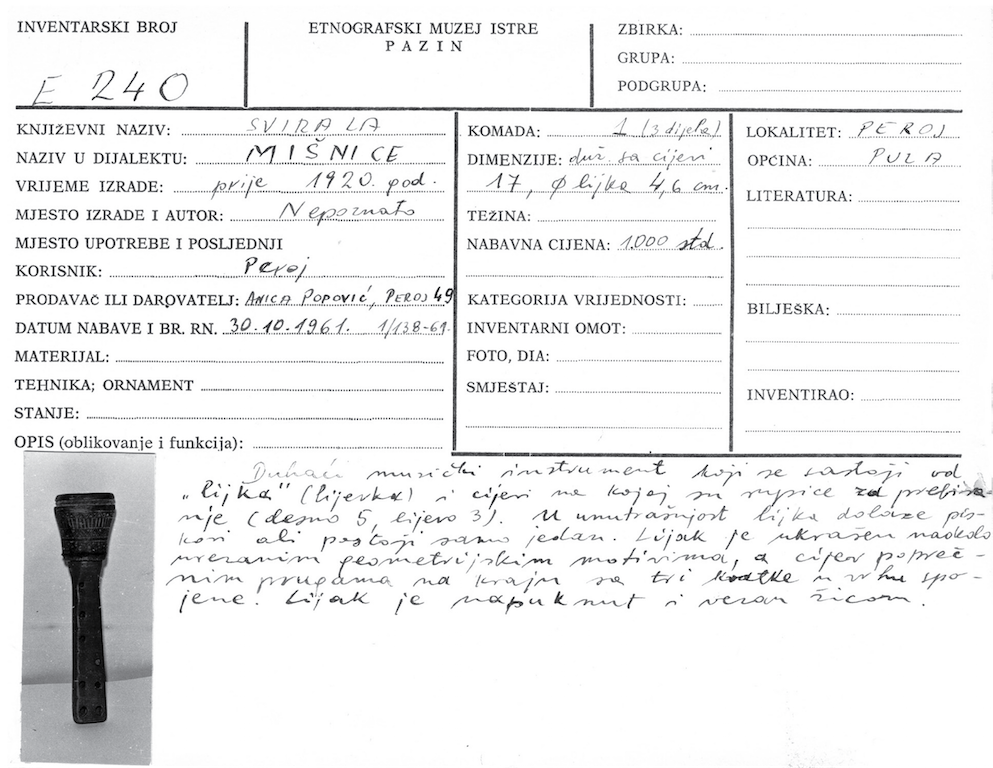 Inventory card of the first recorded instrument from the holdings of EMI / MEI.
Inventory card of the first recorded instrument from the holdings of EMI / MEI.
According to Milićević, significant advances in the production and sale of such items had not occurred. However, in terms of traditional instruments, we can determine almost with certainty that the aforementioned activities, prompted not only production but also distribution in the wider area of Istria and beyond as never before. One of the results of the activities of folk workshop was the idea that with their institution and production access to traditional instruments will be ensured. When in the mid-1980s the workshops closed down, the masters continued with the production independently. In regards to the practice of the use of traditional instruments in everyday life situations it cannot be said that it has taken hold in proportion to production. This is a separate topic, subject to another kind of analysis from the one we offer in this publication. It concerns, in fact, the dynamics that are subject to and are dependent on other life processes regardless of the production of traditional instruments and their availability.
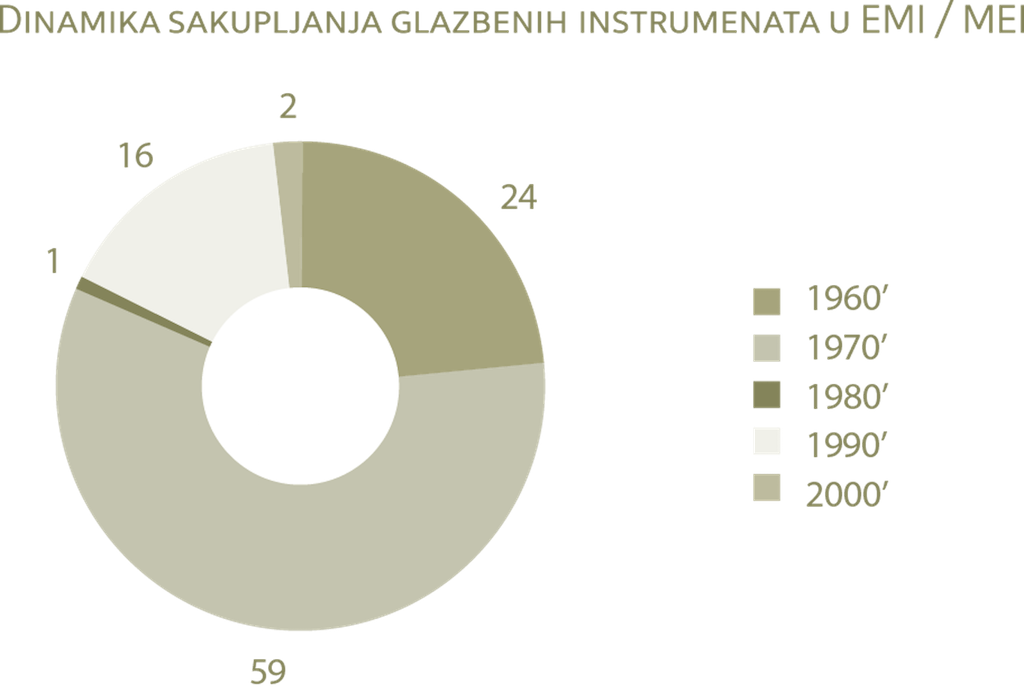 Collecting of musical instruments in EMI/MEI in the period from 1960-2000
Collecting of musical instruments in EMI/MEI in the period from 1960-2000
After this period, the collection of traditional instruments in the Ethnographic Museum is entering a phase of stagnation until 2000. That time much of the instruments were bought from the master Martin Glavaš, one mih (similar to bagpipes) was bought from Walter Primožič from Kršan, and the family Gržinić, a native of Kotla in the Buzet area, donated to the Museum a bass, a violin and a clarinet. In those years a tamburica/cindra (long-necked lute) from Ćićarija, built by Josip Grbac, a master from Lanišće, was purchased. The last purchase of instruments dates back to 2012, when two newly made instruments were bought from Alfonso Konović from the village Jurićev Kal near Barban. It should be noted that some of the items were lost over the years. Thus, the revision from 2010 proved that of the total number of registered musical instruments four were missing. Also, since 1984 five instruments from the museum collection are on loan as a part of the ethnographic collection in the Museum collection Mošcenice.
The museum practice and its tendencies
In the context of traditional culture and heritage of a given area, musical instruments can be considered one of the most recognizable elements of the material culture of the area, in this case - Istria. At the same time, musical instruments open up a wide range of intangible phenomena that we associate with them. This can be applied to any other museum object in the ethnographic collections, but with musical instruments the way the tangible and the intangible complement each other is more than evident. There is a long path from the process of developing instruments to their use and the music that they create, the situations in which it is performed and the changes that occur over time. This path is interwoven with various skills, traditions, personal and collective experiences that add to each individual instrument extra dimensions worthy of recording, protection, interpretation and presentation.
The museum practices and methods, during the period when most of the instruments were collected, haven’t significantly valorised all these potentials, and respectively the characteristics of this type of museum holdings. This is evident from the existing documentation where except for the name, physical characteristics of each instrument, the names and surnames of the makers, the place and time of creation, we can’t find other, more meaningful data. It is understandable that the abilities of documentation on the field were significantly limited by available technology and human resources, but also by the fact that the field work was focused more on collecting and physical properties, and less on the context and history of the instrument. The result is that in the archives of the Museum there is a lack of meaningful data about makers and the process of instrument making, and there is also a lack of concrete information on the instrumental and vocal and dance performing traditions in which these instruments were used (6). There is often a lack of even basic information about the individual instruments, and since we are on this issue it is worth mentioning one extreme case which was discovered during the research: we came to a grounded suspicion that the maker of the largest number of instruments from the Museum holdings – has never existed! Specifically, in the inventory cards the name of the master was, for unknown reasons, incorrectly stated.
It is a maker of instruments for whom the cards in the inventory (and on permanent display) state to be called Antun Glavaš. Suspicion has arisen because the name so far wasn’t found in the published literature on the topic of traditional instruments and music in Istria, and, what is more indicative, none of the still active persons with whom we had a chance to talk to and who deal with the production and performance of traditional music in Istria, heard his name. In addition, the then Secretary of the Chakavian Assembly, within whose Folk workshops Antun Glavaš allegedly was active, had never heard of that name. The only clue we have is his surname which coincides with the known maker of traditional instruments - Martin Glavaš. Also, the address for Antun Glavaš is similar to the address in Pula where Martin lived and worked, in this case the only thing that is not identical is the house number. But the enigma is solved because we found out from Pula's city administration that the house numbers where Martin Glavaš lived were changed.
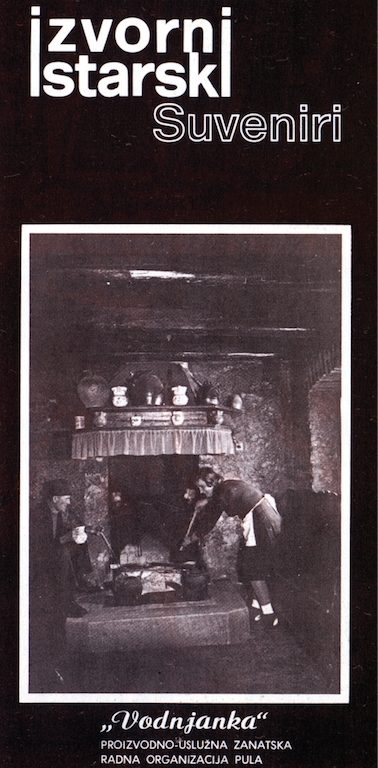 Promotional flyer of the workshop "Original Istrian souvenirs." Source: Miličević, Josip. 1988 Narodna umjetnost Istre. Zagreb: Zavod za istraživanje folklora., p. 121.
Promotional flyer of the workshop "Original Istrian souvenirs." Source: Miličević, Josip. 1988 Narodna umjetnost Istre. Zagreb: Zavod za istraživanje folklora., p. 121.
The former secretary confirmed to us that Martin Glavaš collaborated with the Public workshops. By far the most important fact is that the technique of the making and the ultimate construction of these instruments are in many ways similar to the instruments which Martin Glavaš produced in his later stage. From talking to his nephew Zdenko Glavaš, we found out that it was precisely in those years when the instruments were made and purchased that Martin Glavaš retired and started making instruments more seriously. In his doctoral dissertation, Josip Miličević, singles out Martin, as the then very best maker of instruments and musician among all the masters who contributed to the making of the instruments from the Museum's collections. (Miličević, 1986: 93). All this gives us reason to claim that during the inventory process an error occurred in the labelling of the maker of a large number of instruments purchased for the Museum's collections. The catalogue of this publication will indicate the exact instruments that were mislabelled.
Shifts in museum practice and ethno-anthropological discipline, theoretical principles and methodological approaches today are evident in concrete examples. One of today’s priorities of the Ethnographic Museum of Istria is to direct the work to research and documentation of intangible manifestations of culture, including those aspects relating to traditional instruments and music. Its only aim is not to preserve and exhibit a particular object, but also to learn as much as possible about the "biography" and context of the object. In the case of an instrument, it would mean that we want to know who made it and all the knowledge and skills behind the making; we want to know who used it, in which situations and how it looks and sounds. In this way we create a necessary content heavy documentation basis for further research and consideration of the broader picture of a certain cultural and social phenomenon from an ethno-anthropological point of view with the help of the museum profession. This was the basis for the foundation of the Centre for the intangible culture of Istria in 2011, whose establishment is supported by the fact that the Two-part singing in narrow intervals was listed on UNESCO's Representative List of Intangible Heritage of Humanity in 2009.
Taking into account the development, availability and use of digital technology, not only in our work but also in everyday life, it is clear that there is a qualitative shift in the direction of the set priorities. Unlike the museum practice according to which the public was allowed to see only the occasional object in the permanent or temporary exhibitions, the current tendency is that the results of museum work should be publicly available as much as possible. In addition to the classic exhibition form that is always current, more and more attention is paid to the virtual form, via the Internet and other multimedia tools. This way it is possible to combine different media (video, audio, photos, text) and bring the topic to a wider audience in an informative and educational way. This is testified by the increasingly rich holdings of photo, video and audio documentation stored at the Centre for the intangible culture of Istria, and some of the processed materials are available on the Internet (7).
Virtual collections and exhibitions, databases, digital repositories and publications, along the classic museum exhibition, will certainly become a reality in the coming period as a complementary way for the museum to communicate with the public. This also the path for musical instruments, together with all their intangible aspects - from their creation to the creative and social moment of music-making - necessary to understand the wider context in which it exists.
Footnotes:
1. What preceded the establishment of the Ethnographic Museum in Pazin and its activity was touched in a more detailed form through the exhibition and accompanying publication Memobox: First 50 Years of the Ethnographic Museum of Istria (2012). The publication is available at: http://memoboxblog.files.wordpress.com/2013/02/ knjizniblok_priprema.pdf. More about the process and the socio-historical context of the creation of the museum: Kocković-Zaborski, Tanja. 2014 Founding of the Ethnographic Museum of Istria as part of the process of highlighting the Croatian / Slavic element in Istria.
2. More on the classification of musical instruments from the collection of the Ethnographic Museum of Istria, and of their professional treatment will be discussed in the catalog of this publication.
3. The Ethnographic Museum of Istria touched the theme of Istrian souvenirs in more detail in the exhibition and accompanying catalog called From medals to the symbols of identity, 2000.
4. During that period a large number of other objects and not only traditional instruments were purchased from the same source for the Museum’s collections.
5. The store "Original Istrian souvenirs" led by the labour organization "Vodnjanka" from Pula was opened on Pula’s Forum. After sales launched, as a former associate comments, due to "different interests" of people who have participated in this process, cooperation between the leaders of several Folk workshops and work organizations did not come to life in a satisfactory way.
6. Renato Pernić and his colleagues from Radio Pula with their intensive recording sessions were the most responsible for a rich collection of field audio recordings of traditional music in Istria. The original tape recordings that make up the "Archive Renato Pernić" can be found at the National Archives in Pazin, while much of the digitized material is stored in the study of HRT Radio Pula. As part of the "Archives Renato Pernić", from 2002 to the present date, 12 CD releases with the selected music tracks from the Archives were published.
7. For the video on the subject of traditional instruments and music see: http://vimeo.com/album/2005282; more about the Center for intangible culture of Istria can be found here: http://www.cenki-cecii.com/.